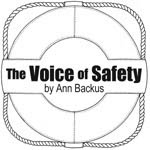The Three-legged Stool
of Electronic Charts
by Ann Backus, MS

Charts, light lists, tide charts, current tables, current notices to mariners, and the U.S. Coast Pilot are among the aid to navigation documents currently required to be present on U.S. flagged vessels. As of Feb 3, 2016, the U.S. Coast Guard made public the Navigation and Vessel Inspection Circular No 01-16 (NVIC 01-16).
This Circular provides that electronic charts and publications constitute “a voluntary equivalency” to the paper charts and other aids to navigation for those vessels required to carry aids to navigation as detailed in Titles 33 and 46 C.F.R.
There are three basic legs in this new voluntary opportunity to use electronic versions of aids to navigation: 1) The Electronic Charting System (ECS), electronic publications and integration with navigation equipment; 2) redundancy; and 3) training.
Electronic Charting System, publications and integration
Note: Electronic equivalency of paper charts applies to domestic paper chart requirements not to chart requirements stipulated by the International Convention for the Safety of Life at Sea, 1974 (SOLAS). Key to compliance is the fact that the electronic charts must be “official charts issued by or on authority of a Government, authorized hydrographic office, or other relevant government institution.” According to a footnote in the Circular, Section 164.33 of Title 33 of the C.F.R. includes the National Ocean Service of National Oceanic and Atmospheric Administration (NOAA) and U.S. Army Corps of Engineers as United States sources for charts.
The following publications may be carried in electronic format as long as they are “derived from the original source, currently corrected/up-to-date and readily accessible on the vessel’s bridge…”: U.S. Coast Pilot, Sailing Directions, Coast Guard Light List, List of Lights, tide-current and river-current tables, Notice to Mariners, Local Notice to Mariners, Notices to Navigation, and Vessel Traffic Rules.
The Circular specifies that if the four following pieces of equipment are installed, they “must be integrated with the ECS in order to meet the equivalency”: “a) external electronic position-fixing device providing position information, b) Automatic Identification System (AIS), c) Gyro-compass…, and d) Marine radar.” Recommended equipment, again to be integrated are the magnetic compass, and the voyage data recorder.
Redundancy
As expected, adopting the electronic versions of paper charts and publications requires that the captain/owner maintain a redundant system - a back-up power supply separate from the main system, a CD, or a complete set of paper charts and publications. The secondary computer system must also be integrated with the four pieces equipment mentioned in the previous paragraph.
Training
Given that A Radio Technical Commission for Maritime Services (RTCM) class ‘A’ ECS satisfies carriage requirements for charts, watch standers and mariners using a class ‘A’ system must be able to produce a completion certificate from a Coast Guard-approved Electronic Chart Display and Information System (ECDIS) course and have “the appropriate endorsement on their Merchant Mariner Credential (MMC). Regarding the RTCM class ‘B’ and ‘C’ ECS vessels operating within 12 nautical miles, crew members credentialed and trained to the standard of these classes for the paper chart environment, must understand the working of the ECS and the associated installed equipment as mentioned above (GPS, AIS, Gyro compass, and radar). “Mariners serving on U.S. flagged vessels, currently holding the ECDIS endorsement on their MMC, are compliant with this Circular and do not require additional training in order to navigate using official electronic charts displayed on an RTCM standard ECS authorized by this Circular.”
The use of electronic charts has the benefit of being able to maintain a current corrected collection of charts and aids, which in turn has a positive implication for safe venturing especially as sand bars and coast lines are subject to considerable natural and storm-made change. The downside is that this electronic collection must have a duplicate system that itself is also tied into the navigational equipment.
Please read NVIC 01-16 at www.uscg.mil/hq/cg5/nvic/default.asp and talk with your local U.S. Coast marine safety officer about the details.
Remember the three-legged stool 1) ECS and electronic publications plus integrated navigation equipment, 2) redundancy, and 3) training. Enjoy your new electronic charts!
Ann Backus, MS is an Instructor in Occupational Health at Harvard School of Public Health, 665 Huntington Ave., Boston MA 02115, 617-432-3327, abackus@hohp.harvard.edu.
